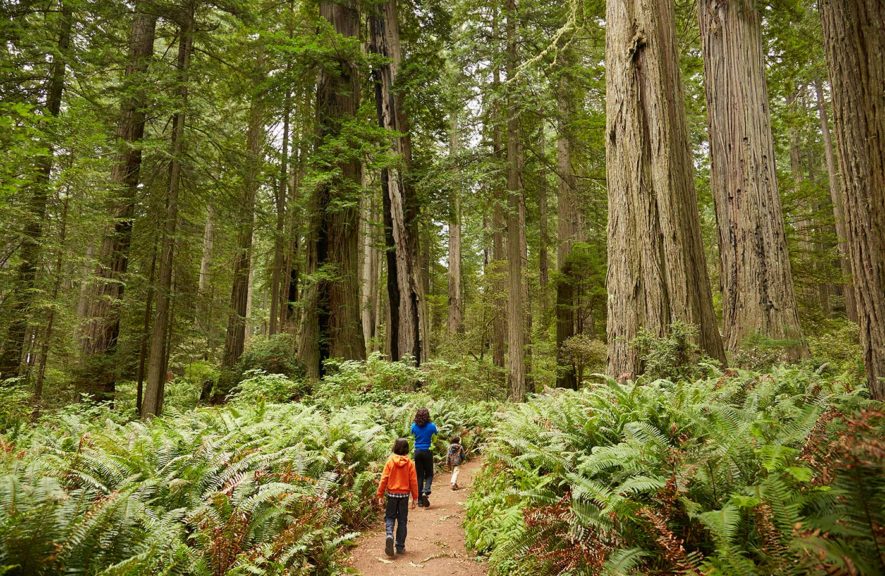I was recently on a very long walk with my daughter. Not two-blocks-with-the-dog-instead-of-one long; rather, we walked 25 km each day, for 5 days. There were all kinds of terrain too: wide open fields, up-and-down rolling hill climbs, a muddy path so narrow that we walked heel-to-toe while grabbing branches for stability, a country border crossing, and literally the seabed at low tide on our last day.
But here is what the walk wasn’t: it was not random. While it was varied and offered surprises, it wasn’t unknown, untraveled, or unmarked. There were boundaries and borders, fences, and footpaths. We were on St. Cuthbert’s Way—a centuries-old pilgrimage walked by thousands before us.
And there was a guidepost every so often that reminded us we were on the right track marked with a known symbol.
Now, these small, yellowed circles with a cross symbol didn’t show up with any regularity. It was just assumed that “this” is the way until another guidepost would steer us otherwise.
And when more time had passed than felt comfortable, all of us would begin to wonder if we’d missed a marker somewhere along the way.

Trusting the Guidebook
There was one afternoon when we realized that, at the top of our highest climb, it appeared that there was one hill seemingly higher than the one on which we stood. Naturally, we let the kids decide if we should also climb that hill. Equally naturally, of course, they wanted to.
There was one concession: climbing the next hill would take us off the path, and we wouldn’t necessarily find a guidepost on the other side. We would have to trust the guidebook (which was more poetic than geographically useful), and each other.
After that extra hill, a fenced wood full of bear traps (Lion? Tiger? Wolf? Who’s to say, really …), and a climb over a barbed wire fence, we found ourselves at the main road that would eventually lead to our bed and breakfast for the day (even though it was after dark when we arrived).
It turns out we only needed that sense of adventure once to realize there was plenty to see on the predetermined path from there on out.
We want kids to be biblically literate: familiar with both the content of Scripture and the character of God who invites us to know Him intimately.
Walking Through the Good Book
Reading the Bible is like a long walk. But I wonder if we are sometimes so concerned with ensuring kids know the stories of Scripture that we miss the opportunity to show them how to wander through the pages and find their way to Jesus.
I wonder if we spend more time introducing them to other people’s stories rather than to who they are because of who He is.
I wonder if we could invite kids to run free in an open meadow where sheep graze, trusting that there are guideposts along the way? What do our kids need to know about Scripture to feel free enough to wander yet be safe enough to explore?
We want kids to be biblically literate: familiar with both the content of Scripture and the character of God who invites us to know Him intimately. But such understanding comes from first deciding: what is our goal?
On the walk, the goal was to get to Holy Island. For me, the goal with Scripture is to point to Jesus, and God’s great big plan for us, His kids, and His Kingdom. We learn from those who have gone before us, and we learn how to go on a long walk with Jesus, in the ways that He walked.

Guideposts for Engaging Kids in God’s Word
Let’s stake out a few guideposts to keep leading kids toward the Way, the Truth, and the Life (John 15), the very Word of God Himself (John 1). When we decide in advance how we want kids to engage with the Bible, we can help shape how it shows up in their lives as disciples:
Always Point to God
The Bible is more of a love letter than a textbook. Rather than pointing to facts alone, what if every moment of it points to a God whose love knows no limits? What if it’s less about the type of wood Noah used than the fact that Noah would be used by the God He loved with his whole life?
God’s Big Story
Every piece of Scripture is tied to the whole—nothing stands alone. We can tell stories one at a time, but not one is isolated from a greater vision for us all. The Bible is one story.
The Hope of the Gospel
Sin doesn’t get the headline—it points us back to the gospel. Sin matters—of course it does. But the gospel is good news. The story of Jesus is good. His life is good. And He was sinless. Starting His story with what we’ve done (sin) is like starting your story with how you hurt your best friend’s feelings. It just might not be the best place to start.
The People of Scripture
The people of Scripture are not characters or superheroes—they are real people. People who have big dreams, are curious, and believe with their whole hearts. They are people who make mistakes. People like you and me. Their relatability is a child’s invitation to participate. God can use all people, any people, available people.
Biblical Language
If we want kids to know the language of Scripture, let’s teach it in the context of Scripture. Try this: every time you read the Bible with kids, put your hand up and say “Stop!” when a word is said that they wouldn’t use in everyday life. Ask what it means. Explain what it means. Carry on. Over time, biblical literacy will shift to comprehension.
Our Identity
Our identity is rooted in the same way our faith is: being confident of what we hope for in Jesus. Who we were made to be is found in the pages of Scripture. Knowing the Bible helps us to know Jesus. Knowing Jesus leads to becoming like Jesus. But if the goal of knowing Scripture is to simply know Scripture, a child may never find their story where it was first written.
God’s Word Is Alive
Character develops through becoming, not simply by knowing the rules of good behavior. The Bible is no more a playbook than a textbook. It is living and active. It will speak, shape, and sharpen those who choose to know it, trust it, and be led by it because it is also loving.
Moving with Wonder
So, I wonder: can we trust the Holy Spirit to speak truth through Scripture to our kids while we unpack it with them? Can we trust that the way markers are visible—not hiding—and that He is calling them by name in the right direction? Our job is to lead them to Jesus, and the Bible is like that beautiful guidebook: poetic, helpful, rich with history and ways to stay the course, but not a geographical survey.
Here’s what I didn’t tell you about that moment when we found ourselves at the road with so far still to go: we phoned a friend. She came and drove us the rest of the way. If we teach our kids anything about knowing the Bible, may they know that it makes more sense, sounds more possible, and reads more like a legacy when we share it together.
Make space for questions. Let “I don’t know” be a good answer and “Who do you want to explore that with?” be an invitation offered often.
When they aren’t sure which way to go, remind them what the way markers look like so that they may find their way back to Jesus. And even when a child decides to climb a hill, may you both know that Jesus goes with them and that He leads them over and beyond the trap-filled woods.
You can read more from Christie here.










